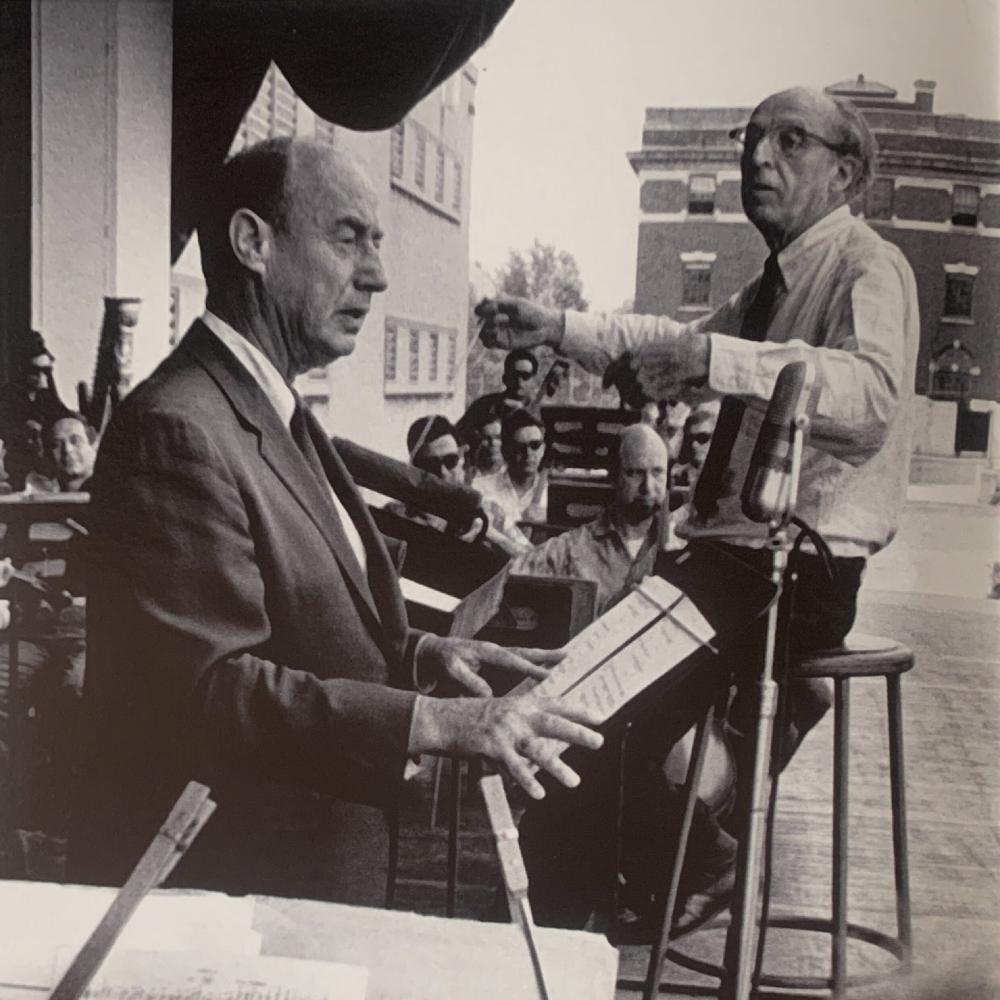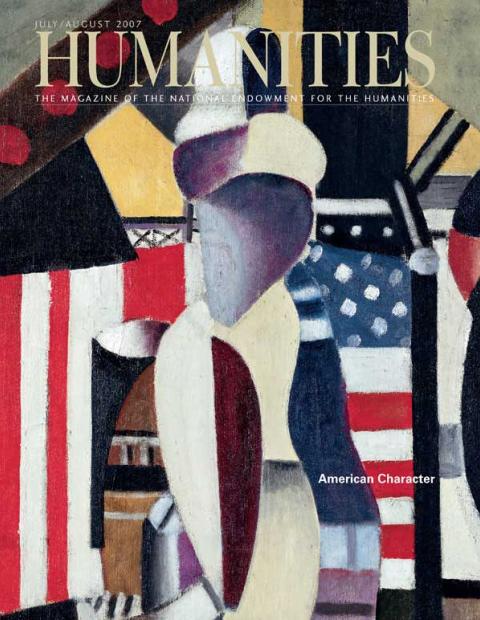Some ten days after news of the attack on Pearl Harbor had circulated throughout the country, the conductor André Kostelanetz wrote to Jerome Kern, Virgil Thomson, and Aaron Copland with a commission. He hoped for three works that would have “a correlated idea in that they are to represent a musical portrait gallery of great Americans.” Kostelanetz suggested George Washington, Paul Revere, Walt Whitman, Robert Fulton, Henry Ford, and Babe Ruth as suitable subjects to memorialize in music. Thomson chose Fiorello LaGuardia, the mayor of New York City, along with the journalist Dorothy Thompson, his colleague at the Herald Tribune. Copland proposed Walt Whitman. But Kern had already selected Mark Twain, and because Kostelanetz did not want two writers in the group of three portraits, Copland turned to Lincoln.
Whitman and Lincoln were hardly random choices: They dominated the historical imagination of the Left—Communists, Democrats, and Popular Front alike. Both men were embraced as representatives from the American past of contemporary and democratic values. And both were associated with the Civil War, opposed to slavery, and committed to preserving the Union.
The sixteenth president was also coupled in the public mind with Roosevelt, who turned to Lincoln early and often during his twelve years in office. In a 1934 “Fireside Chat” on the role of government in the regulation of capitalism, Roosevelt quoted Lincoln to urge management and labor to support recovery programs of the New Deal. “I believe with Abraham Lincoln,” he asserted, “that ‘the legitimate object of government is to do for a community of people whatever they need to have done but cannot do at all or cannot do so well for themselves in their separate and individual capacities.’”
Once the United States had entered the war, Lincoln became a touchstone of authority for the administration as it worked to clarify the aims of the war effort, justify the mobilization, prepare the public for a protracted struggle, and console a nation in mourning. After the bombing of Pearl Harbor in December 1941, the Office of War Information produced posters with a quote from Lincoln’s Gettysburg Address intended to motivate Americans to war as much as to commemorate the dead: “...we here highly resolve that these dead shall not have died in vain.”
As a potent symbol in wide circulation, Lincoln was a fitting subject for Copland’s musical portrait, which he began to write in late February 1942. Unlike Thomson and Kern, who composed purely instrumental portraits, Copland wrote for speaker and orchestra.
As Copland explained, he chose passages not for their familiarity—although the Gettysburg Address is used at the end—but for their contemporary relevance. All of his selections evoke the political and moral challenges to American democracy posed by slavery in the Civil War and fascism in World War II. The narration for Lincoln Portrait speaks eloquently on the subject of slavery, but it also can be seen to reflect a contemporary concern for economic justice and to support the international fight against fascism. In the manuscript drafts for the narration, Copland cobbled together the following from an 1860 letter that Lincoln wrote to his friend Henry Asbury and an address Lincoln delivered that same year at the Cooper Union in New York City: “The fight must go on. The cause of civil liberty must not be surrendered at the end of one or even one hundred defeats. . . . Let us have faith that right makes might, and in that faith let us to the end dare to do our duty as we understand it.” Copland quotes Lincoln to cast the Civil War as one battle in a continuing struggle for freedom.
Copland quotes music as well as text in Lincoln Portrait, setting two traditional American tunes: the eighteenth-century ballad “Springfield Mountain” and Stephen Foster’s minstrel song “Camptown Races.” First to appear is “Springfield Mountain.” The tune and its setting exemplify Copland’s pastoral idiom. The arching disjunct melody is set above a conjunct bass line; the harmony is diatonic; the texture homophonic, even chorale-like; and winds predominate. These musical codes evoke nostalgia, a longing for home tinged with a sense of loss. In one musical phrase, Copland establishes a sense of Lincoln’s time and place, long ago in rural America.
After the introduction of “Springfield Mountain,” the key suddenly brightens to E major, the tempo quickens, and a new theme appears. Fragments of “Camptown Races” are altered and abstracted, but the melodic and rhythmic profile of the tune remains recognizable. High-spirited and rough-hewn, like the young Lincoln of popular memory, “Camptown Races” appears only in this first purely instrumental section. It does not return in the section with the narrator, who assumes the voice of President Lincoln, and if the exuberance of the tune is associated with youth, its disappearance might signal maturity. In his choice and setting of these tunes, Copland captures the two sides of Lincoln as portrayed in Carl Sandburg’s biography: the solemn wartime president and the humble “rail splitter” from the backwoods. After each melody is presented separately, the two are brought together in counterpoint, offering a complete musical portrait of Lincoln as man and president. Then the speaker enters, who intones, “Fellow citizens, we cannot escape history.”
Throughout the section with the narrator, Copland’s original text seems to recapitulate the contrast and combination first presented by the purely instrumental themes. The simple, even folksy, descriptions of what Lincoln looked like, of where he was born and raised, are paired with a more stately and formal declaration that repeatedly introduces Lincoln’s words and so serves as aural quotation marks: “This is what he said, he said . . .” The phrase recalls a similar formulation—“And God said, saying . . .”—that appears frequently in the Hebrew Bible. Surrounded by Copland’s text, Lincoln’s own words sound both human and divine, pragmatic and idealistic.
Many people have narrated Lincoln Portrait since the premiere in 1942. The first was Williams Adams, a radio actor well known for portraying FDR on the series March of Time, which, like the movie newsreels, dramatized current events.
Who reads the text, and how it is read, necessarily influences how the piece is perceived. The presence of General “Stormin” Norman Schwarzkopf enhances the image of Lincoln as a wartime leader. James Earl Jones emphasizes the threefold repetition of “people” in the final line—“of the people, by the people, and for the people”—and in stentorian tones exhorts the listener to action with the righteous anger of an abolitionist. Nebraskan Henry Fonda, on the other hand, carefully measures his intonation to capture Lincoln’s humanity.
Another notable narrator was Coretta Scott King, who read the text in May 1968 in a memorial concert for her slain husband. In the 1950s, Copland witnessed “a fiery young Venezuelan actress” narrate a performance in her home country. After the final lines “the audience of six thousand rose to its feet as one and began shouting so loudly that I couldn’t hear the end of the piece.” The military dictator Marcos Pérez Jiménez was deposed shortly thereafter, and Copland was “later told by an American foreign service officer that the Lincoln Portrait was credited with having inspired the first public demonstration against himÑthat in effect, it had started a revolution.”
The context in which the work is peformed also matters. During the spring of 1942 as Copland was composing Lincoln Portrait, Kostelanetz recalled that “our nation was in one of the darkest days in its history.”
Our Pacific Fleet had been all but destroyed. MacArthur, driven from Manila, was making a last-ditch stand on Corregidor. In Europe, our allies were beaten or facing defeat. France had fallen, Britain was reeling under a hail of fire bombs, and Russia was fighting at the gates of Moscow. Copland finished the rough sketch around Lincoln’s birthday, reworked and polished it that disastrous spring.
Kostelanetz continued, “by the time Copland finished it in April, the tide was starting to turn in the Pacific. . . . Americans were breathing a bit easier.” Just before the premiere on May 14 of that year, the United States scored a victory in the Battle of the Coral Sea, and Lincoln Portrait was met with loud applause. “Lincoln’s warnings fell on victory-deadened ears,” according to the conductor.
But the fortunes of war were to turn again. When Kostelanetz led another performance on July 15, it was clear to all Americans that the war would be long, hard, and costly. The narrator was Carl Sandburg; the First Lady and members of the Roosevelt administration were in attendance. Kostelanetz noted that “it had sunk in that in Europe we were in a war that saw no end. Hitler stood astride a continent and was reaching over Africa, perhaps the world. . . . America was grimly determined—but the road ahead was bloody and dark.”
“Even as I raised my baton,” he remembered, “President Roosevelt was in conferences with Admiral King and General Marshall to chart our course.” On this occasion, Copland’s music and Lincoln’s words “sounded with a terrible new clarity,” the conductor remarked. At the end of the performance there was silence.
Only in the wake of victory does Lincoln Portrait seem to trumpet that victory. In the midst of World War II, at a time when the Allied position was especially weak, it represents something more like hope on the verge of a breakthrough. Copland’s music stands at odds with the historical moment of its enunciations, promising deliverance from its present circumstances and resounding defiantly from the depths of despair. This difference between hope and celebration, between solidarity and authoritarianism, is measured by the different responses of audiences during the war. Following Allied success, Lincoln Portrait was met with applause; it tipped toward an authoritarian grandeur that hallows victory in order to forget the hallowed dead.
But at a time of defeat and uncertainty, Lincoln Portrait meant something else entirely. After the Allied setbacks in 1942, it was met with charged silence. The final sforzando, C-major triad was a wordless voice of providence and hope issued from an outdoor stage, some five hundred yards away from the Lincoln Memorial.


